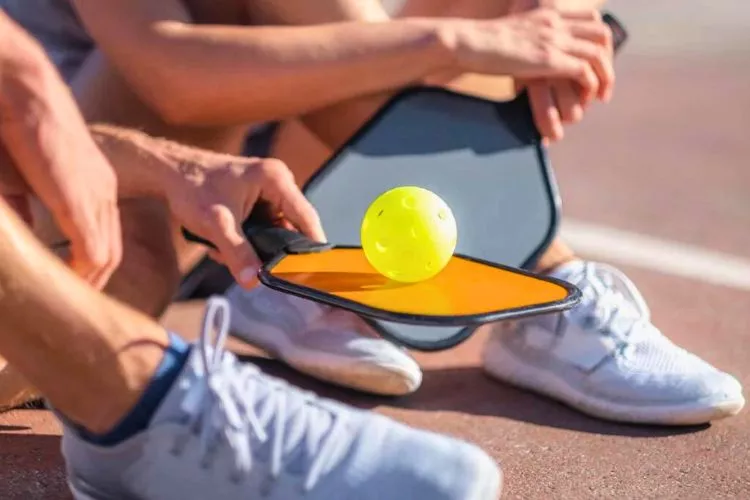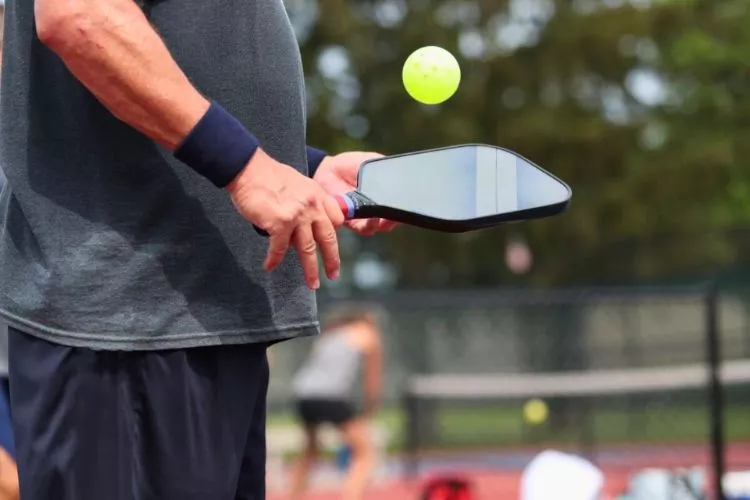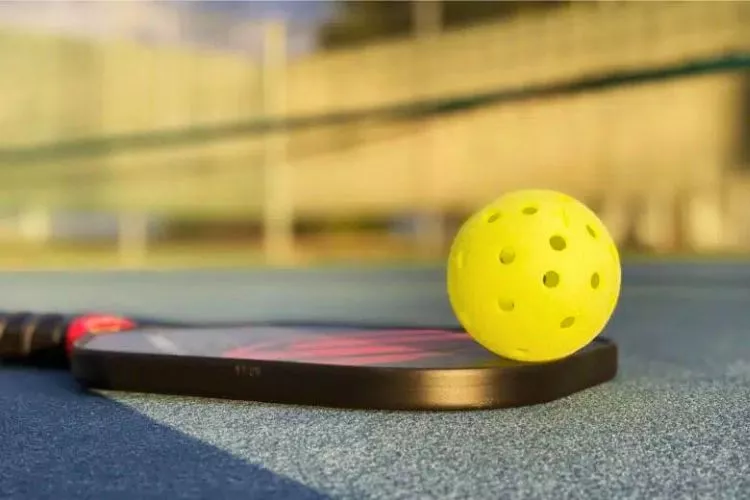Central to the pickleball’s success is the paddle, a critical factor affecting performance on the court. This article explores the benefits of using lightweight paddles in pickleball.
Not only do these paddles offer superior maneuverability, they also induce less fatigue, enabling players to enjoy longer sessions.

Understanding these benefits can be transformative in elevating your game tactics and physical resilience, thereby enriching your pickleball playing experience.
Benefits of Using Lightweight Paddle in Pickleball
Pickleball, though simple at a glance, exemplifies a sport where equipment choices significantly impact performance.
One of the most crucial pieces of equipment in this sport is the paddle. While heavier paddles may offer more power, lightweight paddles provide numerous advantages that can improve your overall game.
Here are some key benefits:
Enhanced Maneuverability
Lightweight pickleball paddles are typically easier to maneuver. This is especially beneficial during volleys, which require quick paddle positioning for effective shot placement.
The lightweight feature allows swift direction changes mid-air, providing an improved angle of shot and better control over the ball’s journey.
Reduced Player Fatigue
In any sport, fatigue can be a major deciding factor in turning the game around. This is especially true for pickleball, where lengthy matches are common.
Lightweight paddles require less physical effort to swing, reducing the workload on your arms and shoulders. Therefore, you can play for longer periods without experiencing muscle fatigue or strain.
Increased Ball Control
As a player, you want as much ball control as possible. Using a lightweight paddle offers better ball control and precise placement.
With reduced paddle weight, it’s easier to direct the ball accurately, ideal for putting your opponents off balance and setting up points.
Prevents Injury
Persistent use of heavier paddles increases the chance of arm and shoulder injuries due to the extra strain.
Utilizing lightweight paddles reduces this risk significantly, enabling players, particularly senior citizens and those with pre-existing conditions, to enjoy the game without worry.
Faster Response Time
In high-paced pickleball games, a fraction of a second can make the difference between winning or losing a point.
Lightweight paddles allow for faster response time, giving you the advantage in sudden death situations where each shot becomes crucial.
Using a lightweight paddle in a game of pickleball can significantly improve your performance and enjoyment of the sport.
While it might not offer the same power as a heavier paddle, the benefits it brings in terms of maneuverability, reduced fatigue, increased ball control, injury prevention, and faster response times make it an invaluable tool for every player.
How do I choose pickleball paddle weight?
Playing with the right pickleball paddle can significantly boost your game. The most crucial factor when choosing a paddle is its weight.
It can influence your control, power, and the likelihood of developing sports-related injuries. Here’s a comprehensive guide to assist you in finding the perfect pickleball paddle weight.

Consider Your Play Style
Your playing style can determine the appropriate weight of your paddle. If power is a major component of your game, a heavier paddle ranging between 7.5 to 8.5 ounces will suit you best.
However, if you prioritize control and precision, a lightweight paddle of around 6 to 7 ounces will be more suitable.
Assess Your Physical Strength
Your physical comfort is paramount while playing pickleball. A paddle that feels burdensome will reduce your endurance and maneuverability.
On the other hand, a paddle that’s too light might lack sufficient power. Evaluate your strength and comfort level when swinging various paddle weights before making a decision.
Factor in Possible Health Concerns
For those with prior joint injuries, especially in the wrists, elbows or shoulders, opting for a lightweight paddle can help minimize stress on these areas.
If you’re unsure, it’s always a good idea to consult a physiotherapist or a health professional before choosing a heavier paddle.
Think About the Duration of Play
If you often engage in long matches or tournaments, a lightweight paddle can be a wise choice, as it reduces arm fatigue and allows you to maintain your performance levels over an extended period.
Conversely, for short, high-intensity burst games, a heavier paddle can be put to good use.
Test Various Paddle Weights
The best way to choose a paddle weight is to test different options. Many sports equipment stores offer demo paddles that you can try before making your purchase.
Take the time to experiment with various weights, aiming to strike a balance between control, power and comfort that suits your play style.
Make an Informed Decision
After testing various weights, assess how each paddle affected your game. Was a certain weight causing fatigue? Did another improve control or power? By answering these questions, you can make a well-informed decision.
Remember, there’s no universally correct paddle weight; each player is unique with individual preferences.
Experiment, play, and discover what feels best for you. As you become more advanced, your preference may change. Be open to re-evaluating your choices to continually improve your pickleball performance.
Can I add weight to my pickleball paddle?
Yes, you can add weight to your pickleball paddle. There are several ways to do so:
- Lead Tape: This is the most common method. Apply strips of lead tape to either the handle or the head of the paddle to increase its weight. The location significantly impacts the balance and feel of the paddle, with handle tape enhancing power and top-heavy tape helping in control and maneuverability. Adjust tape until you find a comfortable weight.
- Grip Enhancements: A thicker or heavier replacement grip can add a significant amount of weight to your paddle. The majority of this extra weight will be in the handle, making the paddle more head-light and improving control.
However, while adding weight can increase power, it can also lead to arm fatigue and potentially increase the risk of injuries. It’s essential to test carefully and ensure you do not detract from your comfort or performance.
Pickleball paddle weight rules
While the USAPA (USA Pickleball Association) and IFP (International Federation of Pickleball) have stipulated numerous rules about pickleball equipment, it’s interesting to note that there are currently no official weight restrictions for pickleball paddles.
However, they do emphasize certain other factors in their guidelines that indirectly relate to the paddle weight:

- Paddle Material: The paddle must be constructed from rigid, non-compressible material. Common materials include wood, aluminum, graphite, and composite, each contributing differently to the paddle’s weight.
- Paddle Dimensions: The combined width and length of the paddle, excluding the handle, must not exceed 24 inches (60.96 cm). The maximum paddle length is 17 inches (43.18 cm). Overall dimensions often have implications on the paddle’s weight.
- Paddle Rigidity: Paddles must not have any features (like springs or flexible sections) that create additional propulsion. Thus, materials ensuring rigidity are preferred, contributing to weight.
While no explicit weight limits exist, most commercially available paddles weigh between 6 to 14 ounces.
This range adheres to both competitive requirements and accommodates player needs for balance, power, and control.
Always check the specifications of a paddle before purchase to ensure it suits your play style and conforms to official guidelines.
Conclusion:
Pickleball, a sport that bridges generations and athletic abilities, is greatly influenced by the choice of paddle.
A lightweight paddle is not just a tool, but an ally, enhancing maneuverability, reducing fatigue, improving ball control, minimizing injury risk, and boosting response time.
While a heavier paddle might provide more raw power, the benefits of using a lightweight paddle make it an excellent choice for a wide variety of players.
In the end, the best paddle is the one that perfectly complements your style, strength, and strategy, taking your pickleball game to new heights.

Pickleball’s more than a game to me—it’s a passion. I write, sharing its highs and lows, the thrills and the lessons. Some tales might draw you to the court, while others give a hint of the game’s magic. So, curious about my journey? Ready to dive deep into the world of pickleball with me? Let’s go.
